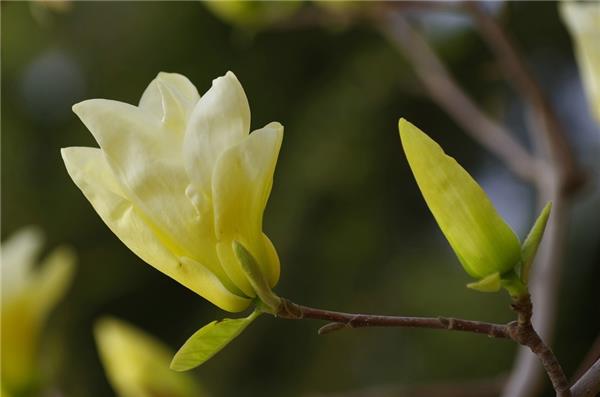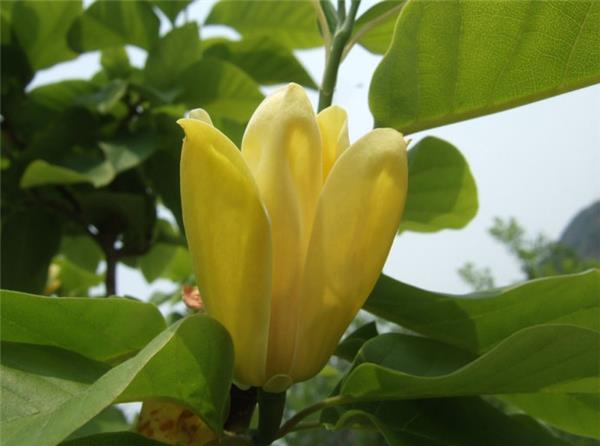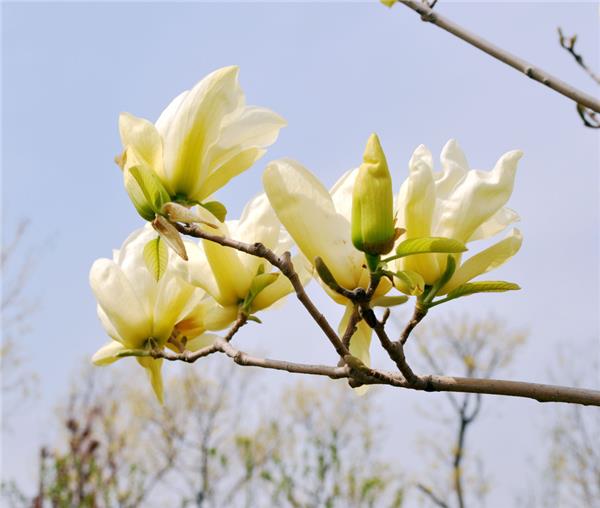Planting management techniques of Magnolia and what are the varieties of the same family?
If Magnolia needs high yield, it is best to carry out it through layering method, so that the survival rate of Magnolia is higher and the growth is healthier.

Techniques of high branch layering and seedling raising of Magnolia grandiflora
The layering method: from April to June, biennial branches are selected, and circular peeling is carried out at the internodes, that is, the branches are clamped with scissors and gently cut in circles, 0.5 cm away from the upper knife edge, and then the bark between the two knives is peeled to expose the xylem. Then use plastic film to tie a bag about 5 cm below the girdling place, put moss or peat soil into the bag, tighten the bag mouth, and then tie the high branch layering on other branches with rope to prevent wind from breaking.
Seedling transplanting: usually 4 to 5 days from the mouth of the bag irrigation into a clear water. After about 40 days, adventitious roots can grow, and their roots are as white as bean sprouts. When the young roots change from white to brown, they can be cut off from the mother, and planted separately in pots or fields. However, it should be noted that the new plants are cut off from the mother, only the plastic film is removed, the moss or peat soil still needs to be retained, and the loose soil will directly affect the survival rate of seedlings. Shading facilities should be set up at the initial stage of new seedling transplantation. After about 5 to 7 days, the shade material can be removed for daily conservation management.

Daily Maintenance and Management of Huang Mulan
Water and fertilizer: Huang Lan likes the soil environment of slight tide deviation F, watering once after planting. Before the seedlings grow new leaves, watering management should be strengthened and the soil should not be dried. In the future, as long as the soil is not too dry, natural rainfall can basically be used to supply water. In addition to applying rotten leaves as base fertilizer before planting, liquid fertilizer rich in nitrogen, phosphorus and potassium should be applied once a week during the vigorous growth season.
Light: In the whole growth process, should ensure that there is appropriate direct sunlight, direct sunlight should not be less than 4 hours a day, avoid environmental shade. Ventilation should be maintained to facilitate photosynthesis.
Temperature: Yellow orchid likes warm, avoid cold, grow well in the temperature range of 20-30℃, winter temperature should not be lower than 5℃, can withstand short-term low temperature of 0℃.
Pests and diseases: in actual cultivation, yellow orchid will be root mold, black spot disease, etc., vulnerable to sting moths, brown soft aphids, dragonflies and other harmful animals attack.

Other Magnolia varieties of the same family as Magnolia
White reserve monarch: deciduous tree, up to 25 meters high, diameter up to 200 cm thick, crown when young narrow oval, mature trees are wide oval or loose wide oval. Seeding origin of trees often trunk obvious, strong tree body, magnificent, strong growth potential, node length branches sparse, but the amount of flowers slightly sparse. Grafted species are often multi-stem or trunk low-branched characteristics, short branches dense, tree body is smaller, but flowers cluster, far view white flawless, enchanting extremely. Therefore, different origins of Magnolia garden application in different tastes, in small or closed gardens, isolated plants or small pieces of plants, should be grafted species, in order to reflect the quaint interest; and scenic areas should be selected to grow species, in order to show the rough and simple style.
2. The plant is a plant belonging to the genus Magnolia. Also known as cinnabar magnolia, purple magnolia. It is a hybrid of Magnolia and Magnolia, cultivated from 1820 to 1840. Small deciduous trees, 6 - 10 m tall. Branchlets glabrous. Leaves obovate, apex acute, midvein base often hairy, abaxially more or less pilose, petiole pilose, stipules one third as long as petiole. Flowers first leaves open, large bell-shaped flowers, purple or red, white inside, fragrant, tepals 6~9.

In addition to being used in landscaping and road greening, Magnolia can also be planted in the courtyard to decorate the courtyard, so if there are friends who want to plant some trees in the courtyard, you can give priority to planting Magnolia.
Related
- Wuhan Hospital Iron Tree Blooming Result Was Instantly Frightened by the Gardener Master
- Which variety of camellia is the most fragrant and best? Which one do you like best?
- What is the small blue coat, the breeding methods and matters needing attention of the succulent plant
- Dormancy time and maintenance management of succulent plants during dormancy
- Minas succulent how to raise, Minas succulent plant pictures
- What are the varieties of winter succulent plants
- How to raise succulent plants in twelve rolls? let's take a look at some experience of breeding twelve rolls.
- Attention should be paid to water control for succulent plants during dormant period (winter and summer)
- Watering experience of twelve rolls of succulent plants
- Techniques for fertilizing succulent plants. An article will let you know how to fertilize succulent plants.



